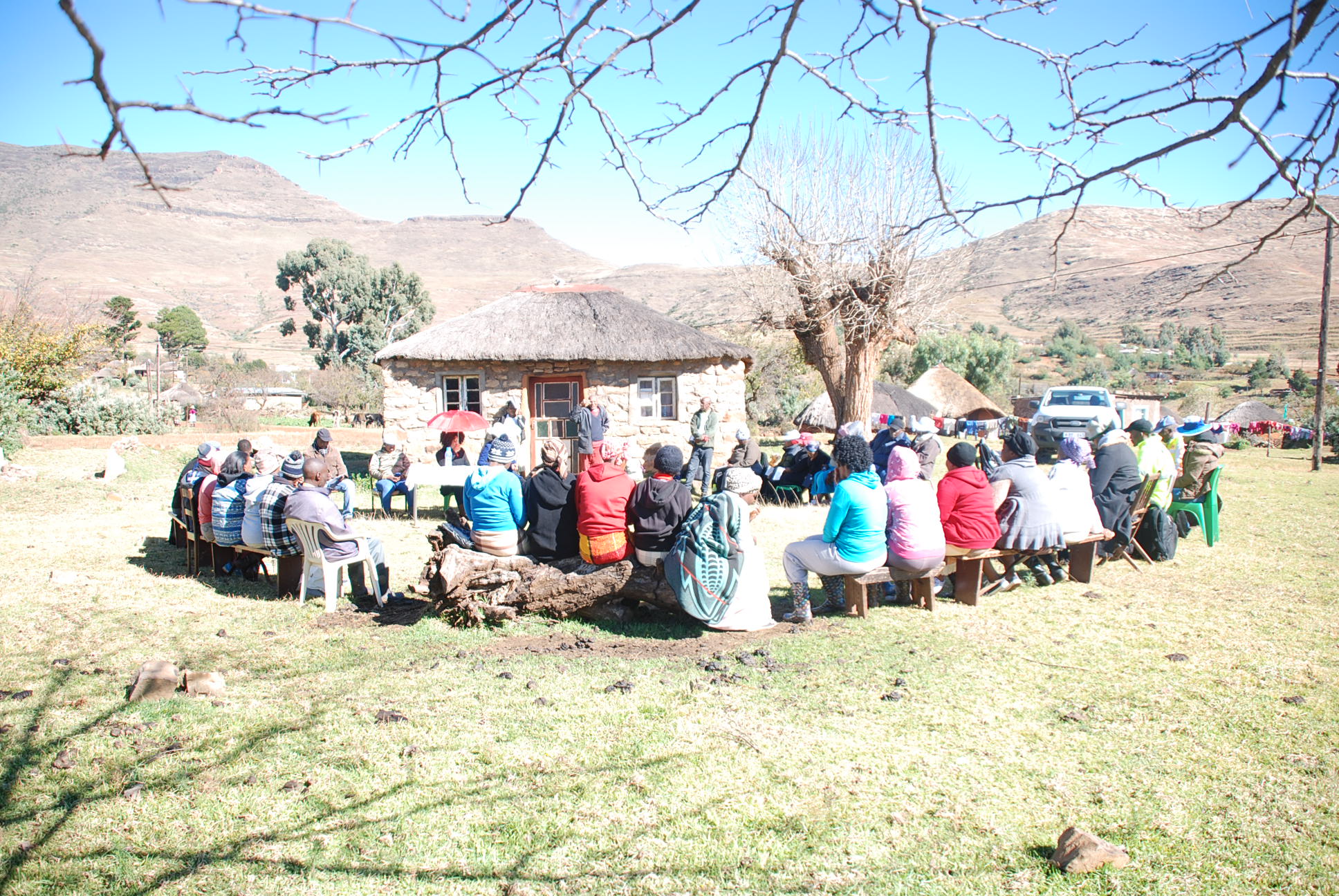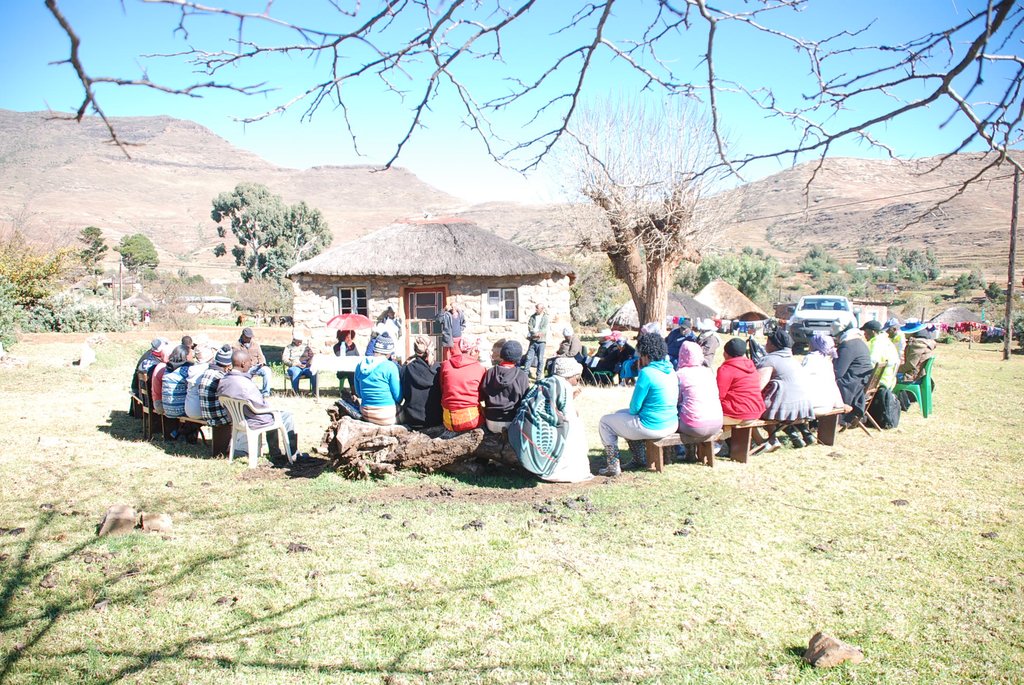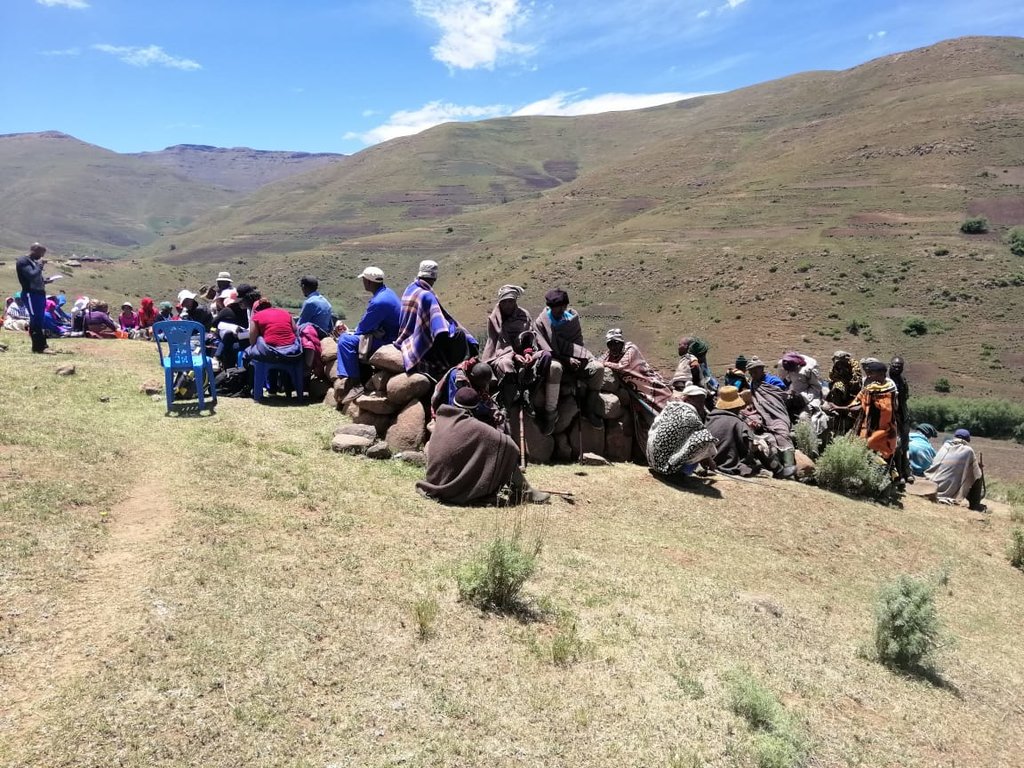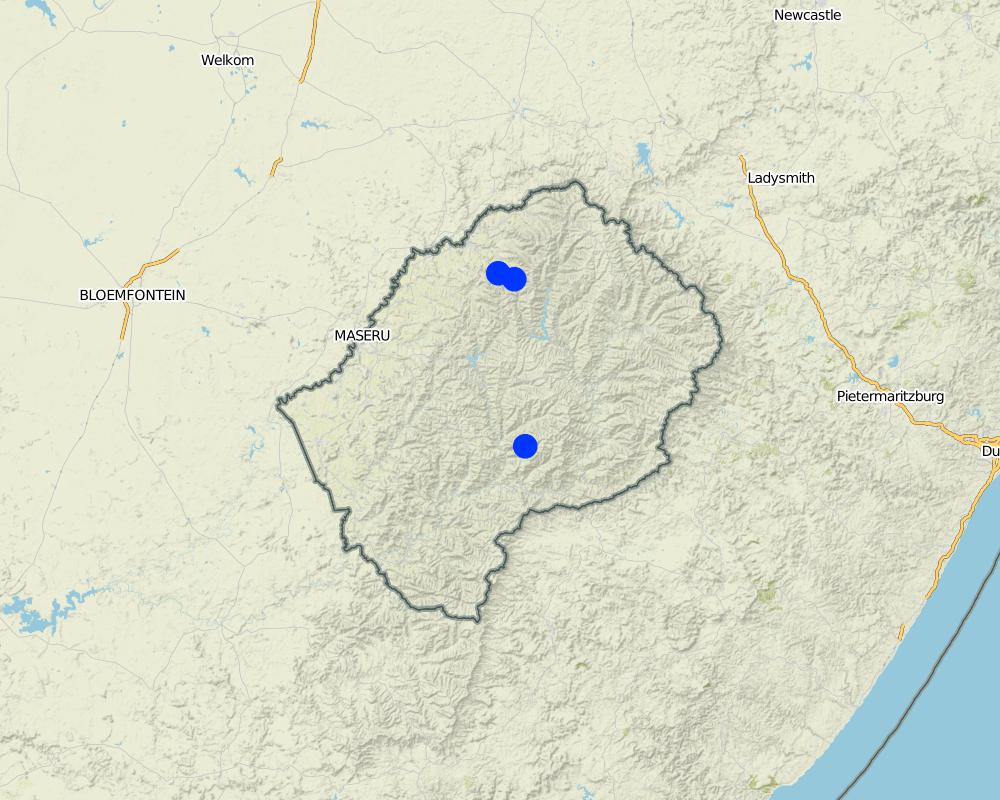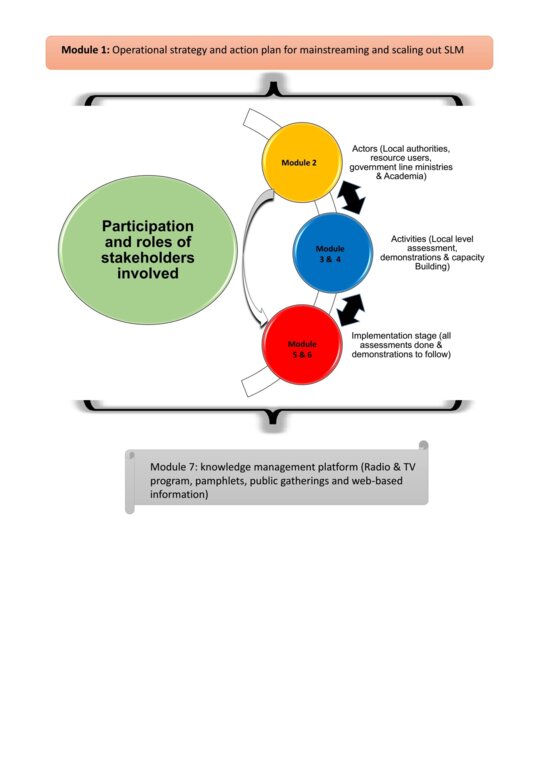Focus Group Discussion [莱索托]
- 创建:
- 更新:
- 编制者: Matoka Moshoeshoe
- 编辑者: –
- 审查者: Rima Mekdaschi Studer, William Critchley
Pitso
approaches_4266 - 莱索托
查看章节
全部展开 全部收起1. 一般信息
1.2 参与方法评估和文件编制的资源人员和机构的联系方式
有助于对方法进行记录/评估的项目名称(如相关)
Decision Support for Mainstreaming and Scaling out Sustainable Land Management (GEF-FAO / DS-SLM)有助于对方法进行记录/评估的机构名称(如相关)
Integrated Catchment Management Project (Integrated Catchment Management Project) - 莱索托1.3 关于使用通过WOCAT记录的数据的条件
(现场)数据是什么时候汇编的?:
27/05/2018
编制者和关键资源人员接受有关使用通过WOCAT记录数据的条件。:
是
1.4 SLM技术问卷的参考
2. SLM方法的描述
2.1 该方法的简要说明
This focus group discussion was composed of 15-20 participants: community elders, youth, (males and females as informed by local beliefs and norms), retired government officials.The aim of community focus group discussion was to find land users’perception and behaviour on land uses and SLM. It was organised by Ministry of Forestry, LADA coordinator and national consultant. The target group was land users, local authorities, youth, small stock owners, retired government officials. The target group mandate was also to draw the community map which also showed the land uses and resources. This focus group discussion gave researchers information on land uses, natural resources, prior SLM interventions, and many more.
2.2 该方法的详细说明
该方法的详细说明:
1. Conducted an initial field visit before the focus group discussion (FGD) with the selected villages within the sub-catchment: A tour by road with a few key informants to familiarise officers with the study area, land uses, also the extent and severity of degradation and types and extent of conservation and improved land management measures with the result being a community territorial map.
2. The aim of Focus Group Discussion (FGD) is to obtain information about range of land-users, their individual and communal management regime and the history of their area. This method is used as the first stage of implementation in LADA local level assessment.
3. The FGD representatives consisted of different social groups (i.e. both men and women – and different age groups) between 15-20 members. These members together with technocrats sat at round table set up which enabled free and interactive communication and feedback.
Each study area had its own list of FGD questions and facilitated them accordingly. Field Assessments confining; six (6) study areas in each sub-catchment.
•Vegetation assessment.
•Soil assessments which entail soil erosion and soil properties (2 study areas).
•Water resources assessment with key informant interviews on water resources.
•Household livelihood assessments.
•Land use systems
4. The target group mandate was also to draw the community map which also showed the land uses and resources. This focus group discussion gave researchers information on land uses, natural resources, prior SLM interventions, and many more. This approach enabled land users to present all their views without fear or dominance by other members. They realised that they have their resources in abundance, however, they need to improve their status as their livelihoods entirely depends on their good use.
5. It was organised by Ministry of Forestry, National University of Lesotho, Ministry of Agriculture, Ministry of Water, Ministry of Local Government,LADA coordinator and national consultant. The target group was land users, local authorities, youth, small stock owners, retired government officials.
6. The advantage of FGD was that the land users were taught on income generating activities such as orchard establishment, food processing, vegetable production under shade nets/tunnels (climate smart agriculture). They did not like the timing of FGD because it interfered with their haresting season, it took longer than it was intended and the weather conditions were not condusive as it was too cold and on the second day, snow began to fall.
2.3 该方法的照片
2.4 该方法的视频
注释、简短说明:
No videos taken
日期:
13/12/2018
位置:
Maseru
摄影师的名字:
N/A
2.5 采用该方法的国家/地区/地点
国家:
莱索托
区域/州/省:
Southern Africa
有关地点的进一步说明:
Focus group discussions were held in three different catchments (Ha Mahloane, Bolahla Pitseng in Leribe district, Lesobeng khutlo se-metsi catchment in Thaba-Tseka district and Ha mosuoe catchment in Quthing district.
注释:
Bolahla-Mphosong catchment
Map
×2.6 该方法的开始和终止日期
若不知道准确的年份,请注明该方法的大致开始日期。:
10-50年前
终止年份(若不再采用该方法):
2030
注释:
On-going
2.7 方法的类型
- 基于项目/方案
2.8 该方法的主要目的/目标
To find land-users views on their status of their natural resources and if they have indigenous knowledge systems applicable to be used in the management method
2.9 推动或妨碍实施本办法所适用的技术的条件
社会/文化/宗教规范和价值观
- 启动
socio-economic factors can hinder the application of this technology
财务资源和服务的可用性/可得性
- 启动
FAOLS country office assisted with finances
机构设置
- 启动
The Lesotho government has provided all conditions necessary
参与者的的协作/协调
- 启动
Other line ministries have fully participated
法律框架(土地使用权、土地和水使用权)
- 阻碍
Lesotho land tenure needs to be reviewed
政策
- 阻碍
The Department of Soil and Water Conservation's policy is still in its draft form.
土地治理(决策、实施和执行)
- 阻碍
In Lesotho, land is communally owned
了解SLM,获得技术支持
- 启动
Farmer-Extension worker ratio is too high to enable adequate scaling up of SLM technologies
市场(购买投入,销售产品)和价格
- 阻碍
limited subsidies towards direct sourcing of specific inputs
工作量、人力资源可用性
- 阻碍
Farmer-Extension worker ratio is too high to enable adequate scaling up of SLM technologies
3. 相关利益相关者的参与和角色
3.1 该方法涉及的利益相关者及其职责
- 当地土地使用者/当地社区
farmers, traditional healers
participants
- SLM专家/农业顾问
soil scientists, agriculturalists, environmentalists and hydrologists
facilitators
- 研究人员
National University of Lesotho (natural resource management researchers)
facilitators/reseachers
- 地方政府
Chiefs and Local councillors
community organisers
- 国家政府(规划者、决策者)
Soil and Water resource line ministries
planning, mentoring and decision support
如果涉及多个利益相关者,请注明领导机构:
Ministry of Forestry, Range and Soil Conservation
3.2 当地土地使用者/当地社区参与该方法的不同阶段
| 当地土地使用者/当地社区的参与 | 指定参与人员并描述活动 | |
|---|---|---|
| 启动/动机 | 互动 | key informants as community representatives |
| 计划 | 互动 | key informants and technocrats working together to produce community maps |
| 实施 | 互动 | technocrats tour guided by community elders |
| 监测/评估 | 无 | |
| 无 |
3.3 流程图(如可用)
具体说明:
This flow chart describes participation of stakeholders in the implementation of DS-SLM activities in Lesotho
作者:
Koetlisi Koetlisi (PhD) and Matoka Moshoeshoe
3.4 有关SLM技术选择的决策
具体说明谁有权决定选择要实施的技术:
- 主要是SLM专家,咨询土地使用者之后
解释:
Technocrats recommend SLM activities to land-users who in turn adopt the suggested technologies attributed to their impact land-users' livelihoods
明确做出决策的依据:
- 对充分记录的SLM知识进行评估(基于证据的决策)
4. 技术支持、能力建设和知识管理
4.1 能力建设/培训
是否为土地使用者/其他利益相关者提供培训?:
否
4.2 咨询服务
土地使用者有权使用咨询服务吗?:
是
指明是否提供了咨询服务:
- 在土地使用者的土地上
- 在固定中心
说明/注释:
There are farmer-farmer visits facilitated by extension workers. There are also agriculture resource centres whereby farmers visit to get more information.
4.3 机构强化(组织发展)
是否通过这种方法建立或加强了机构?:
- 否
4.4 监测和评估
监测和评估是该方法的一部分吗?:
否
4.5 研究
研究是该方法的一部分吗?
是
明确话题:
- 社会学
- 经济/市场营销
- 生态学
提供进一步的细节,并指出是谁做的研究:
Each researcher facilitated their area of speciality and this enabled the question-answer session to be easy. community members had bottle-necks which researchers ironed. The challenge in extension services is means of transport to the landusers due to terrain of our country, so extension service is somehow compromised and not acessible at all times.
5. 融资和外部物质支持
5.1 该方法中SLM组成部分的年度预算
如果不知道准确的年度预算,请给出一个范围:
- 2,000-10,000
注释(例如主要的资助来源/主要捐助者):
FAO-UN
Government of Lesotho
The money caters for accomodation, meals, transport, refreshments for researchers. This is because reseachers do not reside where the FGD was taking place, after the FGD followed LADA local level assessment, which was conducted for 15 days.
5.2 为土地使用者提供财政/物质支援
土地使用者是否获得实施该技术的财政/物质支持?:
否
5.3 对特定投入的补贴(包括劳动力)
- 无
注释:
N/A
5.4 信用
是否根据SLM活动的方法给予信用值?:
否
5.5 其它激励或手段
是否有其他激励措施或工具用于促进SLM技术的实施?:
是
如果是,请具体说明:
There are policies and laws which were referred to in order to support SLM such as Forest Act (1998), Range Resources Management policy (2013)
6. 影响分析和结论性陈述
6.1 方法的影响
这种方法是否有助于基于证据的决策?:
- 否
- 是,很少
- 是,中等
- 是,支持力度很大
participants exchanged information without any hindrance as they were able to learn based on their baseline knowledge
该方法是否帮助土地使用者实施和维护SLM技术?:
- 否
- 是,很少
- 是,中等
- 是,支持力度很大
Land users were only given a theory on the importance of SLM technologies not how technologies are constructed. other researchers were novice in land management, it is though this approach where they learned facilitation skills. In Lesotho, land management activities are implemented mostly by women, youth and elderly because men in the villages work in South African mines. The picture of FGD also portrays more women than men
该方法是否提高了SLM的协调性和成本效益?:
- 否
- 是,很少
- 是,中等
- 是,支持力度很大
This was not part of the agenda
该方法是否提高了土地使用者实施土地管理的知识和能力?:
- 否
- 是,很少
- 是,中等
- 是,支持力度很大
It was agreed that participants would take part in demonstrations that would be implemented later in their respective communities
该方法是否提高了其他利益相关者的知识和能力?:
- 否
- 是,很少
- 是,中等
- 是,支持力度很大
All stakeholders in the natural resources management had a chance to discuss collectively- not in silos, issues that concerned them
该方法是否建立/加强了机构、利益相关者之间的合作?:
- 否
- 是,很少
- 是,中等
- 是,支持力度很大
All stakeholders in the natural resources management had a chance to discuss collectively- not in silos, issues that concerned them. Presence of researchers strengthened this collaboration.
该方法是否有助于社会和经济弱势群体?:
- 否
- 是,很少
- 是,中等
- 是,支持力度很大
该方法是否改善了性别平等并赋予女性权力?:
- 否
- 是,很少
- 是,中等
- 是,支持力度很大
all levels of society were represented
该方法是否鼓励年轻人/下一代土地使用者参与SLM?:
- 否
- 是,很少
- 是,中等
- 是,支持力度很大
The youth were also represented
该方法是否改善了阻碍SLM技术实施的土地使用权/用户权问题?:
- 否
- 是,很少
- 是,中等
- 是,支持力度很大
Lesotho land tenure issues need to be addressed at national level
该方法是否改善了粮食安全/改善了营养?:
- 否
- 是,很少
- 是,中等
- 是,支持力度很大
Officers from Ministry of Agriculture through extension, delivered issues of nutrition and food security
该方法是否改善了市场准入?:
- 否
- 是,很少
- 是,中等
- 是,支持力度很大
There is abundance of natural resources in this area. Members were made aware of markets opportunities around them
该方法是否改善了供水和卫生条件?:
- 否
- 是,很少
- 是,中等
- 是,支持力度很大
Officers from Ministry of Water advised on issues of water and sanitation
该方法是否带来了更可持续的能源使用?:
- 否
- 是,很少
- 是,中等
- 是,支持力度很大
The community entirely depends on the natural resources for better livelihoods
该方法是否提高了土地使用者适应气候变化/极端情况和减轻气候相关灾害的能力?:
- 否
- 是,很少
- 是,中等
- 是,支持力度很大
Climate change issues were also discussed and participants were made aware of the effects.
该方法是否会带来就业、收入机会?:
- 否
- 是,很少
- 是,中等
- 是,支持力度很大
Key informants were asked about their means of livelihoods in the area. This opened income opportunities to some members
6.2 土地使用者实施SLM的主要动机
- 增加生产
Land productivity has been declining attributed to land degradation. SLM is seen as the only measure to help farmers in increasing their production
- 减少土地退化
Lesotho's landscape is severely eroded. Land users would like use SLM as an approach to halt land degradation
6.3 方法活动的可持续性
土地使用者能否维持通过该方法实施的措施(无外部支持的情况下)?:
- 不确定
若否或不确定,请具体说明并予以注释:
Without external support, farmers are not able to implement activities fully
6.4 该方法的长处/优点
| 土地使用者眼中的长处/优势/机会 |
|---|
| Knowledge management |
| It can easily be implemented |
| It brings different land user groups together |
| 编制者或其他关键资源人员认为的长处/优势/机会 |
|---|
| other key resource persons such as local authorities liked this approach because it them ideas on which resources are available in the catchment and how communities utilise them for survival. The land users on the other hand ound this approach very useful as they were empowered and allowed to say their views without fear or favor as they were informed that there were no wrong answers. everybody participated fully |
6.5 该方法的弱点/缺点以及克服它们的方法
| 土地使用者认为的弱点/缺点/风险 | 如何克服它们? |
|---|---|
| It is limited to key informants | It should be replicated within the same community but, with different participants (Key) |
| Some key informants tend to dominate the discussion | The facilitator should be observant and try to control dominating participants |
| It may become a platform for conflicts | Local authorities should be present in case conflicts arise |
7. 参考和链接
7.1 方法/信息来源
- 实地考察、实地调查
15-25 informants, these are representatives of each village whereby each village was represented by 2/3 participants. these are the people who formed FGD
- 与土地使用者的访谈
10% of total households per catchment
7.2 参考可用出版物
标题、作者、年份、ISBN:
N/A
7.3 链接到网络上可用的相关信息
标题/说明:
Ministry of Forestry, Range and Soil Conservation
URL:
https://forestry.gov.ls
标题/说明:
Lesotho Soil Information System
URL:
https://lesis.gov.ls
链接和模块
全部展开 全部收起链接
无链接
模块
无模块


